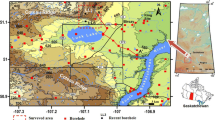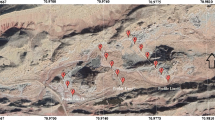Abstract
An indigenous apparatus was devised for measuring the true resistivity of core samples in laboratory or at the drilling site and tested for its efficacy. The true resistivities of selected core samples from a shallow borehole of Brahmaputra alluvium were measured using an in-situ DC resistivity meter and compared with corresponding High-resolution Electrical Resistivity Tomography (HERT) cross section acquired across the borehole site. We find a very good match between the direct measurements and inverse model data of HERT within the limits of resolution. Thus, the present work proves the validity and utility of the resistivity survey in identifying the nature of the sub-surface material and its stratification by measuring the core sample resistivity with the help of in-situ DC resistivity meter.
Similar content being viewed by others
References
Archie, G.E. (1942) The electrical resistivity log as an aid in determining some reservoir characteristics. Trans. Am. Inst. Min., Metall. Pet. Eng. v.146, pp.54–62.
Brace, W.F., Orange, A.S. and Madden, T. R. (1965) The effect of pressure on the electrical resistivity of water-saturated crystalline rocks. Jour. Geophys. Res., v.70, pp.5669–5678.
Chelidze, T.L., Gueguen, Y. and Ruffet, C. (1999) Electrical spectroscopy of porous rocks: a review - II. Experimental results and interpretation. Geophys. Jour. Int., v.137, pp.16–34.
Collet, L.S. and Katsube, T.J. (1973) Electrical Parameters of Rocks in developing Geophysical Techniques, Geophysics, v.38, pp.76–91.
Kaselow, A. and Serge, A.S. (2004) Stress sensitivity of elastic moduli and electrical resistivity in porous rocks, Jour. Geophys. Engg., v.1, p.1.
Kirsch, R. (2006) Groundwater Geophysics, A tool for hydrogeology, Springer Publishers, ISBN 978-3-540-88405-7.
Ramakrishna, T. S. (2006) Geophysical Practice in Mineral Exploration and Mapping. Mem. Geol. Soc. India, no.62, 382p.
Rekapalli, R., Sarma, V.S., Padmavathi Devi, P. and Prasad, P.R. (2013) Electrical resistivity imaging over natural (in situ) geological samples using physical model studies. Arabian Jour. Geosci., p.1, doi: 10.1007/s12517-013-1101-4.
Schmeling, H. (1986) Numerical models on the influence of partial melt on elastic, artelastic and electrical properties of rocks, II, Electrical conductivity, Phys. Earth Planet. Inter. v.43, pp.123–136.
Vinegar, H.J. and Vaxman, M.H. (1984) Induced polarization of shaly sands. Geophysics, v.49, pp.1267–1287.
Author information
Authors and Affiliations
Corresponding author
Rights and permissions
About this article
Cite this article
Rekapalli, R., Sarma, V.S. & Phukon, P. Direct resistivity measurements of core sample using a portable in-situ DC resistivity meter in comparison with HERT data. J Geol Soc India 86, 211–214 (2015). https://doi.org/10.1007/s12594-015-0300-x
Received:
Accepted:
Published:
Issue Date:
DOI: https://doi.org/10.1007/s12594-015-0300-x




